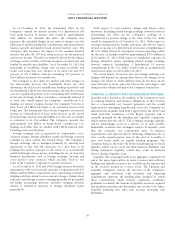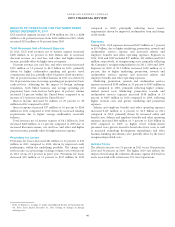American Express 2011 Annual Report Download - page 46
Download and view the complete annual report
Please find page 46 of the 2011 American Express annual report below. You can navigate through the pages in the report by either clicking on the pages listed below, or by using the keyword search tool below to find specific information within the annual report.
AMERICAN EXPRESS COMPANY
2011 FINANCIAL REVIEW
Income Taxes
The effective tax rate was 5 percent in 2011 compared to 9
percent in 2010 and negative 22 percent in 2009. The tax rate in
2011 reflects the allocated share of a tax benefit related to a
distribution of foreign subsidiary earnings with associated
foreign tax credits. The tax rate in 2010 reflects a benefit from
the resolution of certain prior years’ tax items. In addition, the
tax rates in each of the periods primarily reflect the impact of
recurring permanent tax benefits on varying levels of pretax
income. This segment reflects the favorable impact of the
consolidated tax benefit related to its ongoing funding activities
outside the United States, which is allocated to ICS under the
Company’s internal tax allocation process.
GLOBAL COMMERCIAL SERVICES
SELECTED INCOME STATEMENT DATA
Years Ended December 31,
(Millions) 2011 2010 2009
Revenues
Discount revenue, net card fees
and other $ 4,880 $ 4,347 $ 3,882
Interest income 975
Interest expense 264 227 180
Net interest expense (255) (220) (175)
Total revenues net of interest expense 4,625 4,127 3,707
Provisions for losses 76 157 177
Total revenues net of interest expense after
provisions for losses 4,549 3,970 3,530
Expenses
Marketing, promotion, rewards and
cardmember services 547 439 331
Salaries and employee benefits and other
operating expenses 2,927 2,808 2,724
Total 3,474 3,247 3,055
Pretax segment income 1,075 723 475
Income tax provision 337 273 144
Segment income $ 738 $ 450 $ 331
SELECTED STATISTICAL INFORMATION
As of or for the Years Ended December 31,
(Billions, except percentages
and where indicated) 2011 2010 2009
Card billed business $ 154.2 $ 132.8 $ 111.2
Total cards-in-force (millions) 7.0 7.1 7.1
Basic cards-in-force (millions) 7.0 7.1 7.1
Average basic cardmember
spending (dollars)* $ 21,898 $ 18,927 $ 15,544
Global Corporate Travel:
Travel sales $ 19.6 $ 17.5 $ 14.6
Travel commissions and fees/sales 8.0% 8.2% 8.8%
Total segment assets $ 18.8 $ 18.1 $ 16.1
Segment capital (millions) $ 3,564 $ 3,650 $ 3,719
Return on average segment capital(a) 20.4% 12.6% 9.1%
Return on average tangible segment
capital(a) 42.1% 27.1% 19.6%
Cardmember receivables:
Total receivables $ 12.8 $ 11.3 $ 9.8
90 days past billing as a% of total 0.8% 0.8% 1.4%
Netlossratio(asa%ofchargevolume)
(b) 0.06% 0.11% 0.19%
* Proprietary cards only.
(a) Return on average segment capital is calculated by dividing (i) one-year
period segment income ($738 million, $450 million and $331 million for
2011, 2010 and 2009, respectively) by (ii) one-year average segment capital
($3.6 billion for each of the years 2011, 2010 and 2009, respectively). Return
on average tangible segment capital is computed in the same manner as
return on average segment capital except the computation of average
tangible segment capital, a non-GAAP measure, excludes from average
segment capital average goodwill and other intangibles of $1.9 billion at
December 31, 2011, 2010 and 2009, respectively. The Company believes
return on average tangible segment capital is a useful measure of the
profitability of its business.
(b) Effective January 1, 2010, the Company revised the time period in which
past due cardmember receivables in GCS are written off to when they are
180 days past due or earlier, consistent with applicable bank regulatory
guidance and the write-off methodology for USCS. Previously, receivables
were written off when they were 360 days past billing or earlier. Therefore,
the net write-offs for the first quarter of 2010 include net write-offs of
approximately $48 million for GCS resulting from this write-off
methodology change, which increased the net loss ratio and decreased the 90
days past billing metric for this segment, but did not have a substantial
impact on provisions for losses.
44
























